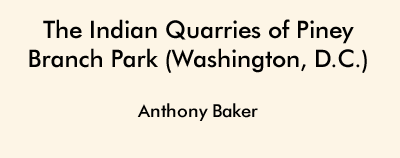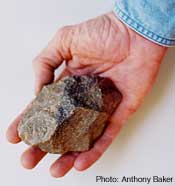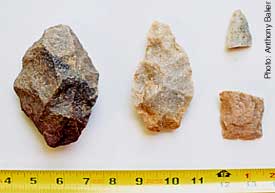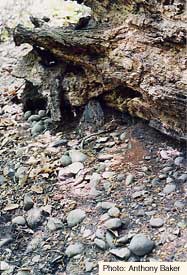|
r e c o m m e n d e d r e a d i n g |
It is an old and majestic forest. The leaves of summer mute the rush of traffic on Piney Branch Parkway in the District of Columbia. One thousand years ago this sylvan glade in Piney Branch Park was an active stone quarry. Much of the ground was a jumble of debris mounds and open pits. For generations, the Nacotchtanks and allied tribes harvested boulders of quartzite dug from the hillsides. From that rock they fashioned knives, arrow points, and tools for domestic use. Soon after the arrival of European colonists, the quarry was abandoned by Native Americans and remained dormant until an archaeological investigation was undertaken by the Smithsonian Institution in the 1890s. Under the direction of William Henry Holmes, the Bureau of Ethnology excavated portions of the quarry. Because it was a quarry, the Bureau’s archaeologists found and studied workshop artifacts in all stages of the manufacturing process, adding greatly to the technical knowledge of how stone tools were made. Importantly, analysis of these artifacts would put to rest the popular notion of an American Paleolithic, or Old Stone Age. The earliest inhabitants of the District of Columbia discovered quartzite boulders exposed at random in stream beds and on foot trails. Cobbles of a finer grain and a thin cross section were easier to flake, and in Piney Branch Park ancient geology had set them in place by the thousands. Carried down from the mountains of antiquity, rounded and smoothed by tumbling, the quartzite cobbles of Piney Branch were quarried by the aboriginal explorers from the ancient banks of the mighty river that shaped them long ago. The production goals of the quarry worker were thin, leaf-shaped quartzite blades. These roughed-out quarry blanks were carried home to village sites, further reduced in size, sharpened by further thinning, and then styled into a variety of edged tools. The first official report of worked stone at Piney Branch was published in the 1880s by the United States Geological survey. Florida Avenue was then the city boundary, and Fourteenth Street, extended, was the access route to the quarry. Fourteenth “Road,” as it was called then, followed the approximate route of present-day Ogden Street, spanning Piney Branch stream by means of a narrow bridge. Obtaining permission from the landowner, Thomas Blagden, Holmes began his archaeological investigation on the bluffs above Piney Branch Stream northwest of Fourteenth Road extended. (This rough, narrow road was soon to be straightened, made grand and wide, and renamed Sixteenth Street.) With the exception of sporadic forays into the woods by street contractors to obtain gravel, the property was undeveloped and heavily wooded. Photographs of the era show it looking much as it does today. The hill above Piney Branch Stream is very steep. Climbing to the top, one passes over deer paths that hug the slope horizontally. Gaps in the tree branches frame a high-rise apartment building and the stone arch of the Sixteenth Street Bridge. Flakes of stone worked by the Indians poke from the soil in profusion; quartzite cobbles by the hundred dot the landscape. These stones are but a clue on the surface to what lies below in numberless profusion. Holmes and his crew dug six ribbon-like trenches that began below the bluff in the narrow but precipitous ravine, ran the hilltop, then continued down the other side, ending close to present-day Crestwood Drive. The trenches were transverse to the bluff so that the broadest view of the quarry workings could be obtained. They did reach their goal, the quarry face. The stones at the working face were held tightly in place by compacted riverine gravel and sand. Holmes proposed that the natives harvested the stone by undermining sections using wooden levers, pickaxes of deer antler, and tools of bone. Temporary camps to house the native workers were built on level sections of the hilltop. The attributes that designate a stone quarry became apparent immediately. Cobbles with chunks knocked off to determine quality, waste flakes, blades broken in the manufacturing process, partially formed and unfinished rejects cast away as unsuitable were found by the bushel. It was these rude implements that were of importance to Holmes. Notable scholars of American antiquity were convinced that implements of such primitive form were analogous to European artifacts dating to the Old Stone Age. Perhaps, thought some, the owners of these so-called tools lived on this continent tens of thousands of years before the “modern Indian” appeared. W.J. McGee, writing in The American Anthropologist of July 1889, asserts: “It seems probable indeed that the quartzite paleoliths of Rock creek were made long before the days of the arrow-makers whose relics skirt the shores of the Potomac and Anacostia.” In the same issue, Thomas Wilson elaborates by accompanying his article with photographs and sketches of these “Paleolithic implements.” Confidently, he states: “Paleolithic implements from the District of Columbia, indeed from all over the United States, are always chipped, never polished; are almond-shaped, oval, or sometimes approaching a circle; the cutting edge is at or towards the smaller end and not, as during the Neolithic period, towards the broad end. They are frequently made of pebbles, the original surface being sometimes left unworked in places, sometimes at the butt for a grip, sometimes on the flat or bottom side, and sometimes, in the cases of these pebbles, on both sides.” Wilson’s paragraph is an apt description of much of the quarry debris scattered on the hillside at Piney Branch, but – this was important – he was off by about one hundred thousand years in suggesting they belonged to the Old Stone Age, and he was wrong in assuming that they were actual tools. He overlooked that fact that reducing a cantaloupe-sized boulder to a practical spear point requires great skill. Quartzite chips with difficulty. Once an initial leaf-shape is roughed out, this lens-shaped form (picture an almond enlarged by a factor of ten) is further reduced by striking off long, thinning flakes with a rock or a baton of deer antler. The minimum acceptable width-to-thickness ratio for an effective projectile point of quartzite is about four to one. Much thicker than that and it will not fly, and it will not slice. Thousands of ungainly “pre-tools” litter the hillside at Piney Branch, and many of them do indeed have the attributes of the chopping, smashing, hand-ax tools carried by our early ancestors. The Smithsonian was intrigued by the possibility of an American Paleolithic. It issued a “Circular Concerning the Department of Antiquities” querying readers for information on “rude or unfinished implements of the paleolithic type.” This circular (No. 36) contained drawings of sample “Paleolithic” artifacts, and was mailed to professionals, learned societies, amateur archaeologists, and artifact collectors. The inquiries in Circular 36 netted hundreds of replies, and many correspondents sent the Smithsonian their “Paleolithic artifacts” for further study. Now we know that archaeologists have pushed back the time line of the aboriginal settlement of the Americas, but they have found no evidence that even the earliest inhabitants devised their tools on these continents. The earliest Americans arrived with tools in hand, and these tools were of the Neolithic type. Today those who replicate the stone tools of the past are called flintknappers, and there are trade journals, conventions, and Internet sites devoted to the avocation. In Victorian America, the knowledge of stone tool technology was in its infancy, despite the fact that in that age of exploration, stone-age societies were being observed and documented. Observing and documenting is always one step behind the practice of doing, and the mechanics behind fracturing stone did not become widely known until archaeologists began experimenting on their own. Piney Branch Quarry was a grand laboratory. It was accessible and very large, and the stone supply was abundant quartzite. The malformed, rejected, and broken implements were so numerous that Holmes, director of the Bureau of Ethnology’s dig, could establish a chronology of the reduction process. He experimented, by following the step-by-step process evidenced by quarry finds, and then reported: “I have found that in reaching one final form I have left many failures by the way, and that these failures duplicate, and in proper proportions, all the forms found on the quarry site.” In a testament to enthusiasm, he wrote further: “I was unfortunately prevented from carrying out these experiments as full as desirable by permanently disabling my left arm in attempting to flake a bowlder of very large size.” In 1897 the Smithsonian published the “Fifteenth Annual Report of the Bureau of Ethnology.” Contained within was a lengthy, superbly-illustrated work titled “Stone Implements of the Potomac-Chesapeake Tidewater Province,” by William Henry Holmes. This master work of quarry-site investigation and lithic analysis won the Loubat Prize as the most important work in American Archaeology of the preceding three years. But his work did not end with excavating Piney Branch Quarry. A quarter-mile north of the Naval Observatory, now the location of the Vice-President’s house, Holmes investigated another Native quartzite quarry. “Although hardly beyond the city limits [he wrote], this site still retains the extreme wildness of a primitive forest and is penetrated by obscure trails only. The sound of the hammer is now constantly heard, however, even in the wildest spots, and suburban avenues threaten it on all sides.” Surely Holmes was pleased when Rock Creek Park was established in 1890. It is now a grand city park of almost eighteen hundred acres. Piney Branch Park is a stone’s throw from the bustle of the city. There, the handwork of the original inhabitants of the District of Columbia still covers the ground in abundance: it is our museum in the woods. Getting there: The quartzite quarries are a few hundred feet west of the Sixteenth Street Bridge, on the north side. If you drive west on Piney Branch Parkway, you come to a traffic turnout just beyond the bridge. You can park there and walk directly into the woods. Good places to spot the quarry debris are in the roots of upturned trees and in the deep ravine where stone has eroded out the sides. Remember, however, that it is illegal to remove archaeological materials from public lands.
Photos from Piney Creek Park
Bibliography: Holmes, William Henry, “Stone Implements of the Potomac-Chesapeake Tidewater Province.” THE ARCHAEOLOGY OF WILLIAM HENRY HOLMES, David J. Meltzer and Robert C. Dunnell, eds. (Washington, D.C.: Smithsonian Institution Press, 1992). W.J . McGee, “The Geologic Antecedents of Man in the Potomac Valley,” The American Anthropologist, Vol. 2, No. 3 July 1889, pp. 227-235.Thomas Wilson, “Results of an Inquiry as to the Existence of Man in North America During the Paleolithic Period of the Stone Age,” Annual Report of the National Museum, 1888, pp. 677-702. ___________, “Paleolithic Period in the District of Columbia,” The American Anthropologist, Vol. 2, No. 3 July 1889, pp. 235-241. “Circular (No. 36) Concerning the Department of Antiquities,” cited in Wilson, “Results of an Inquiry as to the Existence of Man in North America…,” op. cit. Fifteenth Annual Report of the Bureau of Ethnology to the Secretary of the Smithsonian Institution, 1893-94. Washington, D. C.: Gov’t Printing Office, 1897. Note: The original Fifteenth Annual Report of the Bureau of Ethnology is a handsome, splendid book, but it is long out of print. You can order one through an out-of-print book service but will have to spent $150.00 for a decent copy. I would buy THE ARCHAEOLOGY OF WILLIAM HENRY HOLMES, cited above. The article “Stone Implements of the Potomac-Chesapeake Tidewater Province” – first published in the Fifteenth Annual Report of the Bureau of Ethnology – appears in this volume in its entirety. (Anthony Baker lives in Charlottesville, Virginia, where he is a builder and the owner of a bookstore on-line specializing in volumes on American Indians. His “Flintknapping” appeared in Archipelago, Vol. 4, No. 4.) |



